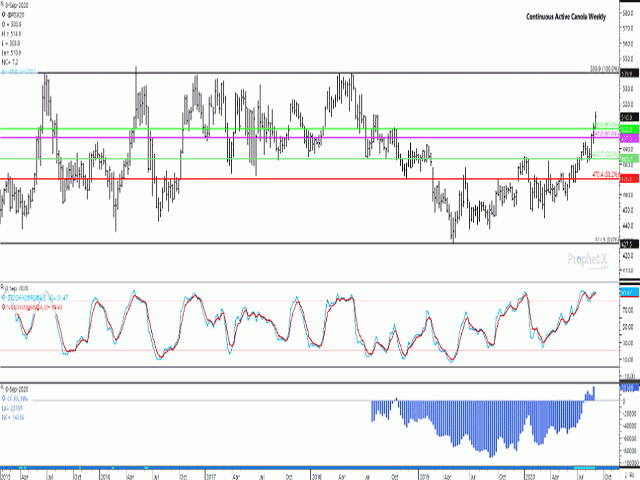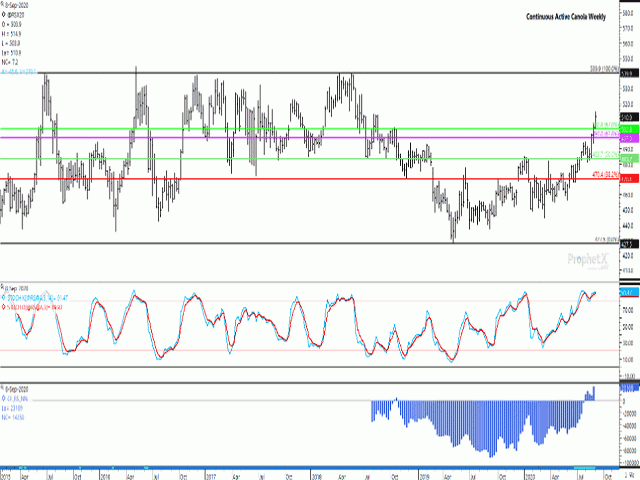Canada Markets
Nearby Canola Surges to More Than 2-Year Highs
Gains in soybeans, soybean oil and palm oil along with Canadian dollar weakness were supportive features for canola to start the week, along with concerns of record-breaking levels of frost for many areas of the central Prairies. Canola continues to move higher in its counter-seasonal rally.
The nearby November contract ended $7.20/metric ton higher, at $510.90/mt, after moving as high as $514.90/mt. A glance at the continuous chart shows the next level of weekly resistance from $525.60/mt to $526/mt, the only price level standing in the way of a test of the May 2018 high of $539.90/mt. Last week's close was above the 67% retracement of the move from the May 2018 high to May 2019 low on the continuous active chart, calculated at $502.80/mt, which also paves the way for a continued move higher.
While CFTC data has only been kept for canola for a little more than two years, the most recent report of Aug. 31 data shows this group boosting their bullish net-long position to a record level of 23,169 contracts (blue histogram bars on the lower study). During the week of Sept. 9, 2019, this same group held a record bearish net-short position of 93,084 contracts.
Twenty locations in Saskatchewan broke records for overnight lows in the early hours of Sept. 8 -- by a wide margin. This undoubtedly played on the emotions of the speculative trade on Tuesday, while may have led to some commercial buying interest.
P[L1] D[0x0] M[300x250] OOP[F] ADUNIT[] T[]
The extent of any damage to crops due to the frost event will take some time to evaluate, while limited to late-seeded or immature crops. Canola Council advises to wait for 4-6 hours after the event in order to evaluate, while low temperatures do not automatically lead to damage done. See Frost Hits Canola. What to Do? At https://www.canolawatch.org/…
Tuesday's trade suggests the effects of this weather event were downplayed. Tuesday's session saw prices settle $4/mt below the session high, while not shown on the chart, the Nov/Jan spread weakened $0.10/mt this session to minus $6.90/mt. This is a move that does not seem to constitute panic buying, while the $6.90/mt carry in the market can be viewed as a neutral signal overall.
In addition to watching harvest progress, we will be looking towards the USDA's views of global canola/rapeseed fundamentals in its Sept. 11 report, while on Sept. 14, Statistics Canada will release another model-based estimate of Canadian crop production, this time based on more-recent August data.
**
DTN 360 Poll
This week's readers' poll asks what you think of the recent decision by Statistics Canada to report the July crop production estimates based on model results, rather than the traditional survey-based methodology, a move that is a part of a longer-term plan. Please feel free to share your thoughts on this poll, found on the lower-right corner of your DTN Home Page.
Cliff Jamieson can be reached at cliff.jamieson@dtn.com
Follow him on Twitter @Cliff Jamieson
© (c) Copyright 2020 DTN, LLC. All rights reserved.





Comments
To comment, please Log In or Join our Community .